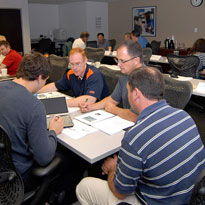LTE
- Course:LTE
- Course ID:LTE-C3DC Duration:3 days Where: Your Office (7+ Persons)
- Download Course Description (PDF)
Available as a private, customized course for your group at your offices or ours and in some cases as a WebLive(TM) class.
Course Outline
- Digital Modulation Overview
- Complex Envelope Representation of Signals and Systems
- Digital Modulation Theory
- BPSK, QPSK, 16QAM and 64QAM
- Pulse Shaping Filter Selection (Nyquist and Raised Cosine Filtering)
- System Metrics: BER, SNR, Eb/No definitions
- Radio Propagation Characterization
- Updated 3GPP Reference Channel Models
- Comparison with Earlier HSPA Channel Model Versions
- Performance Improvement Techniques
- Forward Error Correction
- Convolutional: Viterbi Algorithm, Punctured Coding
- Turbo: Encoder and Decoder
- Interleaver/De-interleaver: Advantages and Disadvantages
- Performance Comparisons
- Antenna Receiver Diversity Techniques
- Switching, Equal Gain, Maximal Ratio, Optimal Combining
- Theoretical SNR improvement and BER Performance
- Forward Error Correction
- 3GPP WCDMA System Review
- 3GPP Release Overview (Release 99 to Release 8 Features)
- High Speed Downlink Packet Access (HSDPA) Overview
- High Speed Uplink Packet Access (HSUPA) Overview
- Network Architecture (NodeB, RNC, CN)
- Partitioning of Protocol Stack Across Network
- OFDM Principles
- Transmission and Modulation: Subcarrier, IFFT, S/P, Etc.
- Sub-carrier Discussion
- Peak-to-Average Power Ratio (PAPR) Impact
- Reception and Demodulation: FFT, P/S, Etc.
- Purpose of Cyclic Prefix (CP)
- Design Tradeoffs
- Multipath Mitigation Techniques
- How Different Standards Resolve Multipaths
- TDMA vs. CDMA vs. OFDMA Solutions
- LTE System Components (Building Blocks)
- System Goals: Latency, Throughput, Etc.
- Discussion: Trend toward IP Services
- LTE Signaling Channels (UL and DL)
- Logical Channels
- Physical Channels
- Network Architecture (E-UTRAN, EPC)
- Element Interfaces
- Protocol Architecture (RRC, RLC, MAC)
- Partitioning of Protocol Stack Across Network
- OFDM Details for LTE
- Transmission (IFFT, S/P, Etc.)
- Sub-carrier Discussion
- Reception and Demodulation (FFT, P/S, Etc.)
- Values of Cyclic Prefix (CP)
- OFDM Receiver
- MIMO (Channel Capacity, MAP, MMSE Equalization, Etc.)
- FDD and TDD Modes
- System Goals: Latency, Throughput, Etc.
- LTE System Scenarios
- Paging
- Idle Mode States
- Random Access Procedure
- Link and Resource Adaptation
- Security Architecture
- Brief Comparison with WiMAX
- Cell Search and Handoffs
- Intra-Frequency Measurements
- Call Flow Diagrams
- Mobile Originated
- Mobile Terminated
- Antenna Transmit Diversity Techniques
- Space Time Block Codes
- Closed Loop Antenna Arrays
- MIMO
- Link Budget and System Capacity Examples
- Link Budget Methodology
- Link Budget Equations
- Rise Over Thermal Calculation
- Example for Indoors and Outdoors Link (Excel Spreadsheet)
- Cell Capacity Example
- Targeted Frequency Bands
- Wrap-up: Course Recap and Discussion
Course in a Nutshell
The course begins with a review of the digital modulation techniques, radio propagation characteristics, and the 3GPP WCDMA system. This is followed by a discussion of the principles of OFDM, multipath mitigation techniques, and the LTE system components. The course concludes with a comprehensive look at the various LTE system operation scenarios and a study of link budget and system capacity examples.
Customize It!
We can customize this course to suit the needs of audiences such as hardware designers, application developers, service designers, sales engineers, marketing/sales personnel, radio planners, and persons involved in defense and homeland security applications relating to LTE.
Aimed At
This course is aimed at technical professionals who are familiar with 2G, 3G, and/or other 4G (such as WiMAX) wireless technologies and desire a comprehensive overview of the LTE technology.
Prerequisites
Familiarity with 2G/3G technologies or WiMAX.
- "The instructor knows the material very well ... good diagrams of system behavior ... always has a good balance between serious and light hearted." - DR, Systems Engineer, US Department of Defense

